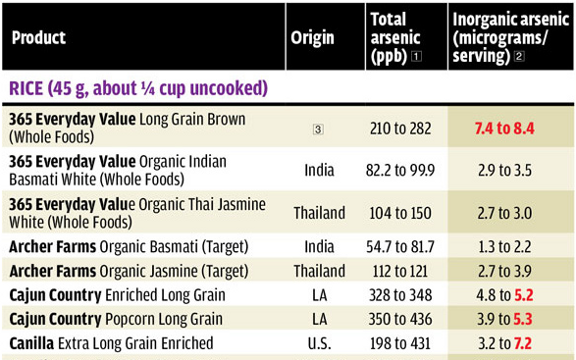Healthful Rice: Report Shows Rice Least Contaminated with Arsenic

 Rice isn’t a terrible food, but it’s important to avoid questionable GMO rice rejected by China and contaminating U.S. crop fields. And it’s really important to avoid rice that’s contaminated heavily with arsenic. There have been reports of high arsenic content in rices grown in USA regions where cotton used to be grown and arsenic laced pesticides have seeped into that soil used for growing rice. Rice from China has cadmium issues as well.
Rice isn’t a terrible food, but it’s important to avoid questionable GMO rice rejected by China and contaminating U.S. crop fields. And it’s really important to avoid rice that’s contaminated heavily with arsenic. There have been reports of high arsenic content in rices grown in USA regions where cotton used to be grown and arsenic laced pesticides have seeped into that soil used for growing rice. Rice from China has cadmium issues as well.
According to Consumer Reports, it appears that organic basmati white rice from India, sold at Target and Trader Joe’s, has the lowest levels of arsenic they tested, and white rice generally has less arsenic than brown rice. The results are at the bottom of this article.
But there’s an even better, safer type of basmati (long-grain) white rice that is imported from India and recommended by Ayurvedic doctors as the most digestible and nutritious type of white rice. It’s known as parboiled basmati rice.
It’s not boiled or precooked the way we normally think. Parboiling rice is a method of removing the bran from rice while retaining most of the nutrients lost with other bran removal processes. Parboiled rice contains more fiber, magnesium, calcium, potassium, vitamin B3 (niacin) and vitamin B6 than regular white rice. So it’s close to brown rice nutritionally but much easier to digest.
Parboiled rice is harder to find than other organic basmati white rice because it’s sold in international Asian or Indian specialty food stores. But parboiled basmati white rice can also be purchased online.
Explaining Parboiled Rice
Here’s an excerpt from the SFGate online magazine health section:
“Unlike brown and white rice, the process [of bran removal] for parboiled rice begins before the hull is removed. The complete grain of rice is soaked, steamed and dried, then the hull is removed to make parboiled rice.
The steaming enables the rice to absorb nutrients and changes the starch so that it cooks into a firmer, less sticky dish of rice than regular white rice. The steaming does not precook the rice, so it still takes about 20 minutes to prepare.” [Emphasis added]
Cooking Details
The first step is to thoroughly rinse the rice’s protective mineral oil coating by running strong-pressured water through the rice in a strainer, which you shake rapidly from side to side. When the water turns clear, the rice is clean.
Read: Potentially Dangerous GMO ‘Golden Rice’ Fed to Children without Warning
For cooking, use water purified with a combination of both carbon filter and reverse osmosis processing. Most health food stores and even regular supermarkets have machines that process tap water with that purifying combination for 25 to 50 cents per gallon.
All you’d need for steaming your rice is a heavy, medium-sized stainless steel, ceramic, or Pyrex glass pot with a heavy lid that seals well. Rice cookers are more suitable for steaming larger portions of rice to feed a banquet or party, and they should be aluminum free. Stove-top cooking parboiled basmati white rice is the same as cooking other white rices. Use slightly less than a two to one ratio of water (with a pinch of sea salt) to rice. When it comes to a boil, place the tightly sealing heavy lid onto the pot and bring the heat down to low.
Cook for 20 to 30 minutes without lifting the lid and releasing the steam (if you can resist). It should be done by then. If there’s still any water showing, continue for a few minutes more. Different brand/sources vary with their cooking time.
Enjoy a tasty, more nutritious, relatively arsenic-free rice any way you’d like.

Additional Sources:

Very informative. Thank you for sharing this.
The amt. Is infintessimal. Uncle Bens is fine for me